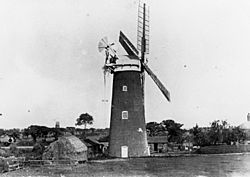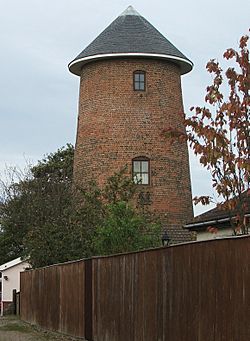Corton Windmill facts for kids
Quick facts for kids Corton Mill |
|
|---|---|
 
The mill in 1910 (above) and the converted mill (below)
|
|
| Origin | |
| Mill name | Corton Mill |
| Mill location | TM 542 974 |
| Coordinates | 52°30′55″N 1°44′44″E / 52.51528°N 1.74556°E |
| Operator(s) | Private |
| Year built | 1837 |
| Information | |
| Purpose | Corn mill |
| Type | Tower mill |
| Storeys | six storeys |
| No. of sails | Four Sails |
| Type of sails | Patent sails |
| Winding | Fantail |
| Fantail blades | Six blades |
| No. of pairs of millstones | Two pairs |
| Year lost | Early 20th century |
Corton Mill is a historic windmill in Corton, Suffolk, England. It is a special type of windmill called a tower mill. This mill is so important that it is a "Grade II listed" building. This means it's protected because of its history and special design. Today, Corton Mill is no longer used for grinding grain. Instead, it has been changed into a home where people live.
A Look Back: Corton Mill's Story
Corton Mill was built in 1837. That's almost 200 years ago! It was built to grind corn into flour. This was a very important job before modern factories existed.
The mill stopped working before the First World War. This was in the early 1900s. After it stopped grinding corn, one of its top floors was removed. This made the mill shorter than it used to be. For many years, the building was used as a storage place. Later, it was turned into a house.
How Corton Mill Was Built
Corton Mill was a tall building with six floors. It was a tower mill, meaning its main structure was a strong, round tower.
Key Parts of the Mill
- Cap: The very top of the mill was called a "cap." Corton Mill had a cap shaped like a boat. This cap could turn to face the wind.
- Fantail: To help the cap turn, the mill had a "fantail." This was a small windmill at the back of the cap. It had six blades. When the wind blew, the fantail would spin. This spinning would automatically turn the main cap. It made sure the big sails always faced the wind.
- Sails: Corton Mill had four large "Patent sails." These were special sails that could be adjusted easily. They had ten sections, each with three shutters. These shutters could open or close to catch more or less wind.
- Millstones: Inside the mill, the sails turned a large shaft. This shaft then powered two pairs of "millstones." These heavy stones would grind the corn into flour. The mill was built with space to add two more pairs of millstones if needed.

